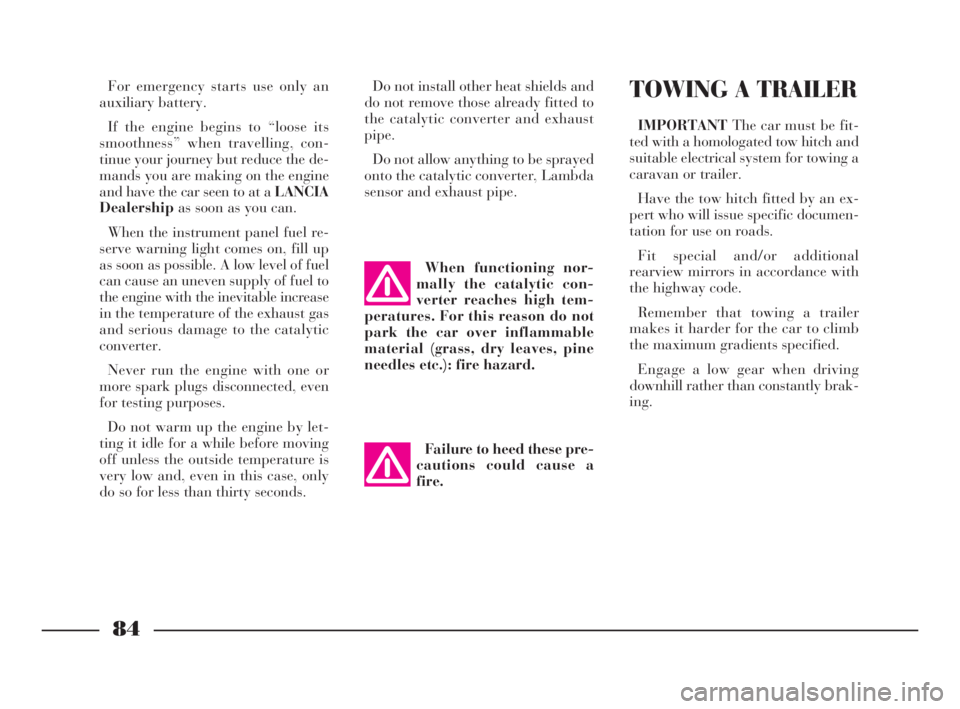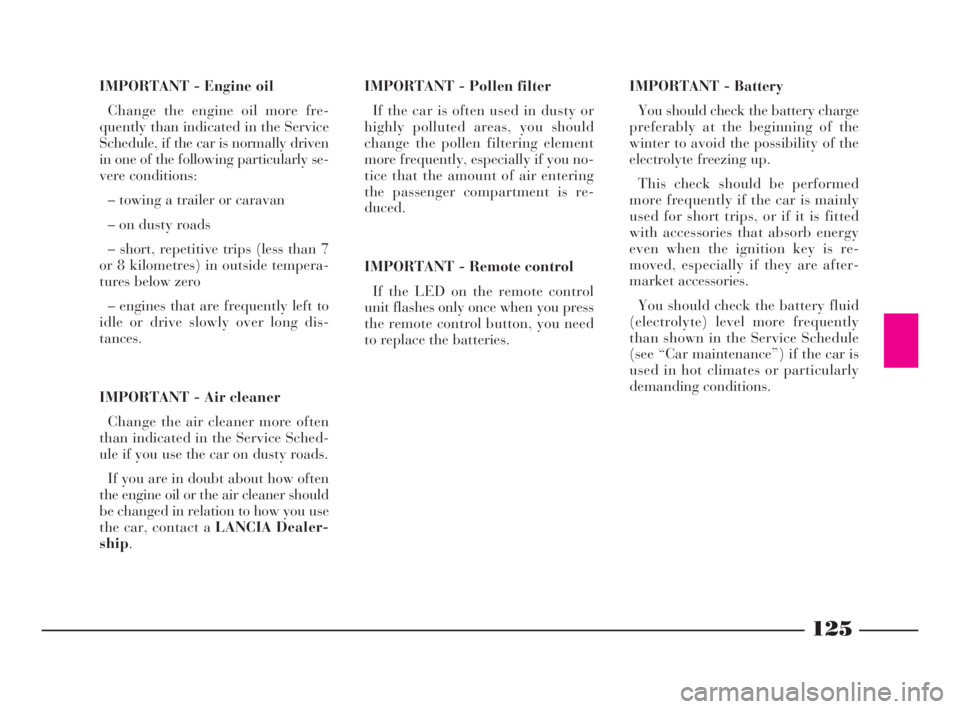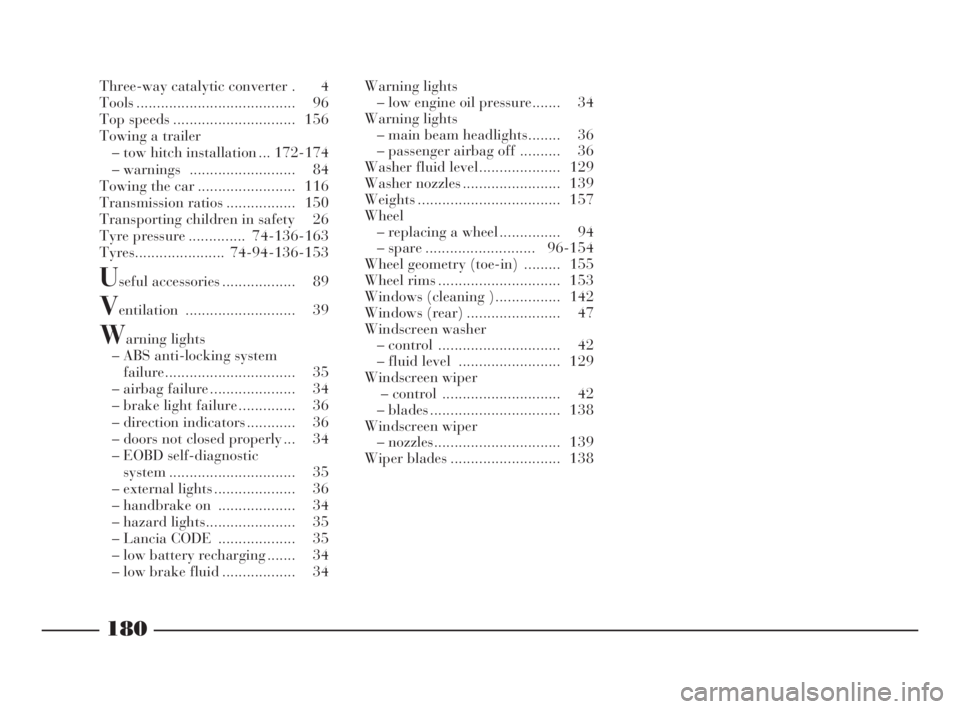towing Lancia Ypsilon 2002 Owner handbook (in English)
[x] Cancel search | Manufacturer: LANCIA, Model Year: 2002, Model line: Ypsilon, Model: Lancia Ypsilon 2002Pages: 191, PDF Size: 2.45 MB
Page 71 of 191

DRIVING YOUR CAR
To help you handle your car in the best and
safest possible way, and above all use it to its fullest
potential, we have given you some hints in this
chapter on “what to do, what not to do and what
to avoid” when at the wheel of your Lancia Y.
Most of the time, these suggestions apply to
other cars as well. Sometimes, however, the tip
may apply to an exclusive Lancia Y feature. You
are therefore strongly recommended to pay the
closest attention to this section for helpful hints
on optimum driving practices and usage of the car
that will help you get the most out of your car. STARTING THE ENGINE .............................. 69
PARKING ....................................................... 71
GEAR USE ..................................................... 72
AT THE FILLING STATION .......................... 73
SAFE DRIVING .............................................. 75
CONTAINING RUNNING COSTS
AND POLLUTION ......................................... 81
CHEAP RUNNING THAT RESPECTS
THE ENVIRONMENT ................................... 83
TOWING A TRAILER .................................... 84
SNOW CHAINS .............................................. 85
SNOW TYRES ................................................ 86
STORING THE CAR ...................................... 87
REPEATED CHECKS AND CHECKS
BEFORE LONG TRIPS .................................. 88
ACCESSORIES PURCHASED
BY THE OWNER ........................................... 88
USEFUL ACCESSORIES ............................... 89
68
G
4C068-089 ING 11-03-2008 11:59 Pagina 68
Page 73 of 191

70
G
HOW TO WARM UP
THE ENGINE AFTER
IT HAS JUST STARTED
– Begin to move forward slowly let-
ting the engine turn over at medium
revs. Do not accelerate abruptly.
– Do not push the engine to its limit
for the first few kilometres. You are
recommended to wait until the water
temperature has reached 50°C to
60°C (pointer moves slightly from its
initial position).
EMERGENCY STARTING
If the Lancia CODE system fails to
recognise the code transmitted by the
ignition key (warning lamp ¢on in-
strument panel lit with a fixed light),
you can start the engine by following
the emergency procedure using the
code written on the CODE card.
See the section “In an emergency”.STOPPING THE ENGINE
Turn the ignition key to STOPwhile
the engine is idling.
Remember that as long as
the engine is not running,
the brake booster and
power steering do not work. You
therefore have to use considerably
more effort on both the brake
pedal and the steering wheel.
Bump starting by push-
ing, towing or rolling
downhill must be avoided
at all costs. This way of starting
could cause a rush of fuel into the
catalytic exhaust pipe and damage
it beyond repair.
BUMP STARTING
A quick burst on the ac-
celerator before turning off
the engine serves ab-
solutely no practical purpose, and
wastes fuel.
IMPORTANTAfter a taxing drive it
is better to allow the engine to “catch
its breath” before turning it off by let-
ting it idle to allow the temperature in
the engine compartment to fall.
4C068-089 ING 11-03-2008 11:59 Pagina 70
Page 86 of 191

83
G
Traffic and road conditions
Heavy traffic and higher consump-
tion are synonymous; for example,
when driving slowly with frequent use
of the lower gears or in large towns
where there are numerous traffic
lights.
Winding roads, mountain roads and
bumpy roads also have a negative ef-
fect on consumption.
Enforced halts
During prolonged hold-ups (traffic
lights, level crossings) the engine
should be switched off.LOOKING AFTER EMISSION
CONTROL DEVICES
The correct use of pollution control
devices not only ensures respect for
the environment but also has an effect
on the car’s performance. Keeping
these devices in good condition is
therefore a fundamental rule for dri-
ving that is easy on your pocket and
on the environment too.
The first step to take is to follow the
Service Schedule to the letter.
Use only unleaded petrol.
If you have trouble starting, do not
keep turning the ignition key for long
periods. Be especially careful to avoid
bump starting the car by pushing,
towing or rolling down hill: these are
all manoeuvres that can damage the
catalytic exhaust.CHEAP RUNNING
THAT RESPECTS
THE ENVIRONMENT
Environmental protection has been
one of the guiding principles in the
production of the Lancia Y. It is no ac-
cident that its pollution control equip-
ment is much more effective than that
required by current legislation.
Nonetheless, the environment can-
not get by without a concerted effort
from everyone.
By following a few simple rules you
can avoid harming the environment
and often cut down fuel consumption
at the same time.
On this subject, a few useful tips
have been given below to supplement
those marked by symbol #at various
points of the handbook.
You are asked to read both the for-
mer and latter carefully.
4C068-089 ING 11-03-2008 11:59 Pagina 83
Page 87 of 191

84
G
For emergency starts use only an
auxiliary battery.
If the engine begins to “loose its
smoothness” when travelling, con-
tinue your journey but reduce the de-
mands you are making on the engine
and have the car seen to at a LANCIA
Dealershipas soon as you can.
When the instrument panel fuel re-
serve warning light comes on, fill up
as soon as possible. A low level of fuel
can cause an uneven supply of fuel to
the engine with the inevitable increase
in the temperature of the exhaust gas
and serious damage to the catalytic
converter.
Never run the engine with one or
more spark plugs disconnected, even
for testing purposes.
Do not warm up the engine by let-
ting it idle for a while before moving
off unless the outside temperature is
very low and, even in this case, only
do so for less than thirty seconds.When functioning nor-
mally the catalytic con-
verter reaches high tem-
peratures. For this reason do not
park the car over inflammable
material (grass, dry leaves, pine
needles etc.): fire hazard.
Failure to heed these pre-
cautions could cause a
fire.
Do not install other heat shields and
do not remove those already fitted to
the catalytic converter and exhaust
pipe.
Do not allow anything to be sprayed
onto the catalytic converter, Lambda
sensor and exhaust pipe.TOWING A TRAILER
IMPORTANTThe car must be fit-
ted with a homologated tow hitch and
suitable electrical system for towing a
caravan or trailer.
Have the tow hitch fitted by an ex-
pert who will issue specific documen-
tation for use on roads.
Fit special and/or additional
rearview mirrors in accordance with
the highway code.
Remember that towing a trailer
makes it harder for the car to climb
the maximum gradients specified.
Engage a low gear when driving
downhill rather than constantly brak-
ing.
4C068-089 ING 11-03-2008 11:59 Pagina 84
Page 88 of 191

85
G
The ABS system with
which the car may be fitted
does not control the brak-
ing system of a trailer. Special care
must therefore be taken on slip-
pery surfaces.
Under no circumstances
modify the car’s braking
system for trailer braking
control. The trailer’s braking sys-
tem must be completely indepen-
dent of the car’s hydraulic system.The weight the trailer exerts on the
car’s tow hitch coupling reduces the
car’s carrying capacity by the same
amount.
In order to be sure you are not ex-
ceeding the maximum towing weight
(given on the car’s registration pa-
pers), you have to take into account
the trailer’s weight fully laden in-
cluding the accessories and personal
luggage.
Do not exceed the speed limits for
towing a trailer in the country you are
driving in. In any case, do not exceed
the top speed of 100 km/h.SNOW CHAINS
The use of snow chains is regulated
by the legislation in force in the coun-
try the car is driven in.
The chains may only be applied to
the drive wheel tyres (front wheels).
Use only low profile chains (maxi-
mum height off the tyre: 12 mm).
Check the tautness of the chains af-
ter driving some twenty to thirty me-
tres.
IMPORTANTAs the spare wheel is
small (space-saver), it is not possible
to fit snow chains to it. If a front tyre
is punctured, first exchange a rear
wheel with the spare tyre and then
change the flat tyre with the rear wheel
thus removed. This way there will be
two ordinary wheels at the front and
the snow chains can be fitted.
Remember that the wheels should
always be exchanged on the same side
of the vehicle; never change wheels
over from one side of the car to the
other.
4C068-089 ING 11-03-2008 11:59 Pagina 85
Page 97 of 191

94
G
into the catalytic exhaust
pipe and damage it beyond
repair.
BUMP
STARTING
Bump starting by pushing, towing
or rolling downhill must be
avoided at all costs. This way of
starting could cause a rush of fuelRemember that as long as
the engine is not running,
the brake booster and
power steering do not work. You
therefore have to use considerably
more effort on both the brake
pedal and the steering wheel.
IF A TYRE
IS
PUNCTURED
GENERAL INDICATIONS
The following precautions must be
observed when changing a wheel and
using the jack and the space-saver
spare wheel.
4C090-119 ING 11-03-2008 12:00 Pagina 94
Page 119 of 191

116
fG
IF THE CAR NEEDS
TO BE TOWED
The tow ring is supplied as standard
with the car.
How to attach the tow ring to the
car:
1)Take the tow ring out of its sup-
port, located under the boot carpeting.
2)Remove the flap in the bumper,
using a screwdriver to pry it off.
3)Screw ring A (fig. 42)onto the
threaded pin B (fig. 43)orC (fig. 44)
which can be seen when the cover is
removed.When towing the car, you
must adhere to the specific
traffic regulations regard-
ing the tow hitch and how to tow
on the road.
B- front anchorage point (fig. 43).
C- rear anchorage point (fig. 44).
fig. 42
P4C00135
fig. 43
P4C00412
fig. 44
P4C00003
4C090-119 ING 13-03-2008 12:51 Pagina 116
Page 120 of 191

117
fG
While the car is being
towed with the engine off,
remember that the brake
pedal and steering will require
more effort as you no longer have
the benefit of the brake booster
and power steering. Do not use
flexible cables to tow. Avoid jerk-
ing. Whilst towing, ensure that the
coupling to the car does not dam-
age the surrounding components.Do not extract the igni-
tion key during towing;
leave it at MAR, to prevent
the steering lock engaging and,
provided the electrical system is
not damaged, keep the brake lights
and direction indicators working.
When the ignition key is re-
moved, the steering lock will cut in
thus preventing the steering wheel
from being turned.IF AN ACCIDENT
OCCURS
– It is important to keep calm.
– If you are not directly involved,
stop at least ten metres away from the
accident.
– If you are on a motorway do not
obstruct the emergency lane with your
car.
– Turn off the engine and turn on
the hazard lights.
– At night, illuminate the scene of
the accident with your headlights.
– Act carefully, you must not risk
being run over.
– Mark the accident by putting the
red triangle at the regulatory distance
from the car where it can be clearly
seen.
– If the doors are jammed, do not try
to leave the car by breaking the glass
of the windscreen as the glass is strat-
ified. Side windows and the rear win-
dow can be broken more easily.
4C090-119 ING 13-03-2008 12:51 Pagina 117
Page 128 of 191

125
G
IMPORTANT - Battery
You should check the battery charge
preferably at the beginning of the
winter to avoid the possibility of the
electrolyte freezing up.
This check should be performed
more frequently if the car is mainly
used for short trips, or if it is fitted
with accessories that absorb energy
even when the ignition key is re-
moved, especially if they are after-
market accessories.
You should check the battery fluid
(electrolyte) level more frequently
than shown in the Service Schedule
(see “Car maintenance”) if the car is
used in hot climates or particularly
demanding conditions. IMPORTANT - Engine oil
Change the engine oil more fre-
quently than indicated in the Service
Schedule, if the car is normally driven
in one of the following particularly se-
vere conditions:
– towing a trailer or caravan
– on dusty roads
– short, repetitive trips (less than 7
or 8 kilometres) in outside tempera-
tures below zero
– engines that are frequently left to
idle or drive slowly over long dis-
tances.
IMPORTANT - Air cleaner
Change the air cleaner more often
than indicated in the Service Sched-
ule if you use the car on dusty roads.
If you are in doubt about how often
the engine oil or the air cleaner should
be changed in relation to how you use
the car, contact a LANCIA Dealer-
ship.IMPORTANT - Pollen filter
If the car is often used in dusty or
highly polluted areas, you should
change the pollen filtering element
more frequently, especially if you no-
tice that the amount of air entering
the passenger compartment is re-
duced.
IMPORTANT - Remote control
If the LED on the remote control
unit flashes only once when you press
the remote control button, you need
to replace the batteries.
4C120-143 ING 11-03-2008 12:01 Pagina 125
Page 183 of 191

180
fdG
Three-way catalytic converter . 4
Tools ....................................... 96
Top speeds .............................. 156
Towing a trailer
– tow hitch installation ... 172-174
– warnings .......................... 84
Towing the car ........................ 116
Transmission ratios ................. 150
Transporting children in safety 26
Tyre pressure .............. 74-136-163
Tyres...................... 74-94-136-153
Useful accessories .................. 89
Ventilation ........................... 39
Warning lights
– ABS anti-locking system
failure................................ 35
– airbag failure ..................... 34
– brake light failure .............. 36
– direction indicators ............ 36
– doors not closed properly ... 34
– EOBD self-diagnostic
system ............................... 35
– external lights .................... 36
– handbrake on ................... 34
– hazard lights...................... 35
– Lancia CODE ................... 35
– low battery recharging ....... 34
– low brake fluid .................. 34Warning lights
– low engine oil pressure....... 34
Warning lights
– main beam headlights........ 36
– passenger airbag off .......... 36
Washer fluid level.................... 129
Washer nozzles ........................ 139
Weights ................................... 157
Wheel
– replacing a wheel ............... 94
– spare ........................... 96-154
Wheel geometry (toe-in) ......... 155
Wheel rims .............................. 153
Windows (cleaning )................ 142
Windows (rear) ....................... 47
Windscreen washer
– control .............................. 42
– fluid level ......................... 129
Windscreen wiper
– control ............................. 42
– blades ................................ 138
Windscreen wiper
– nozzles............................... 139
Wiper blades ........................... 138
4C177-184 Indice ING 13-03-2008 13:31 Pagina 180